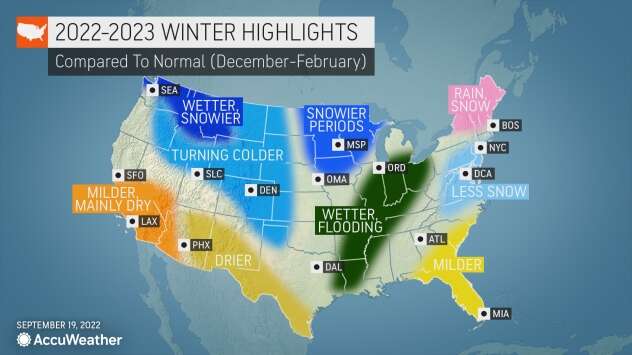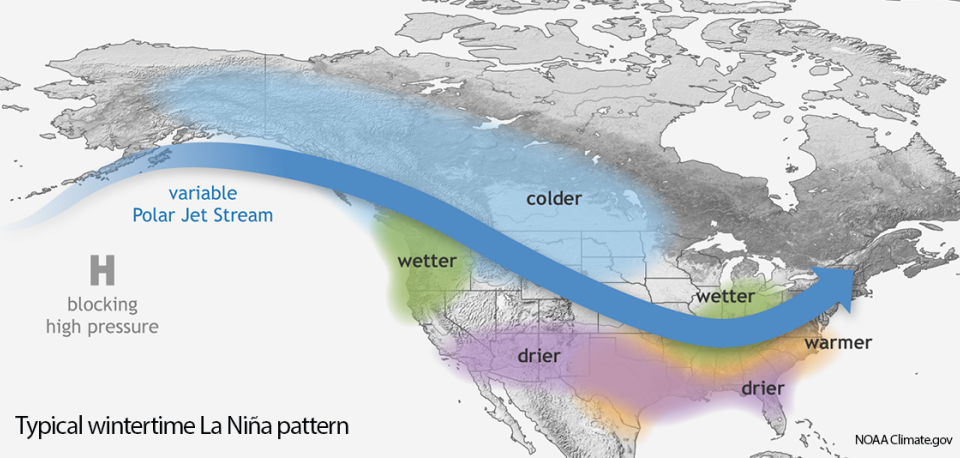Large parts of Wisconsin could see a snowier than normal winter, according to AccuWeather's long-range forecast
With temperatures expected to dip across Wisconsin this weekend as a cold front moves in from Canada, it may be time to get out flannels and turn on the furnace, but what about breaking out snow shovels?
Not yet, despite a few expected flakes in northern Wisconsin Friday morning. Most of Wisconsin could see periods of snowier than usual weather later in the winter, according to AccuWeather's long-range winter forecast.
Mild start to winter until the calendar flips to 2023

According to the prediction, one of the strongest weather patterns affecting us this winter will be La Niña, a phenomenon where water around the equator in the central and eastern Pacific Ocean is cooler than normal.
The National Oceanic and Atmospheric Administration predicts this winter will be the third in a row influenced by La Niña. Essentially, that means there's a greater likelihood of wetter, colder weather in the northern United States, and warmer, drier weather in the South.
So, before winter wraps up, Wisconsin — especially in the north — could see more snowier periods than usual, according to AccuWeather's winter highlights map.
More: 'Triple dip' La Niña is on the way. Here's what it means for weather in the US
More: What is La Niña? Does it bring more snow? How climate pattern could affect US weather.

Still, even with La Niña present, AccuWeather also predicts the Midwest won't see regular blasts of cold air and snow until mid-winter, around January and February.
Once the cold weather arrives, however, it could be rough. According to AccuWeather's senior meteorologist Paul Pastelok, "February is the month to watch for the polar vortex to usher in brutally cold Arctic air across the Rockies and most of the central U.S."
More: Why is it so cold? How the polar vortex brings record low temperatures and winter storms
More: What is the polar vortex? In-depth look at how it can affect winter weather in the US.
Around the same time, according to the prediction, the path of storm systems could change, bringing heavier snow to the eastern Great Plains and the mid-Mississippi Valley and potentially splashing precipitation onto Wisconsin.
But these forecasts could be altered by one more unusual factor. The eruption of the Hunga Tonga-Hunga Ha’apai volcano in January in the Pacific Ocean shot a massive cloud of water, steam and ash into the atmosphere, increasing the amount of water vapor in the stratosphere by 5%.
This, according to NASA, might even be enough to temporarily raise the Earth's temperature, since water vapor traps warmer air onto the Earth's surface as a blanket would.
However, Pastelok had "lower confidence" that this would substantially change the winter forecast.
More: Tonga volcano eruption was the biggest in over a century and it reached space, studies say
Seasonal predictions have their limitations
The Old Farmer's Almanac and AccuWeather both forecast a colder winter for Wisconsin, though they differ on where more snow will fall. Both organizations say they use weather data from previous years in order to make their predictions.
Still, while AccuWeather touts its winter forecast as one of the "most highly anticipated seasonal outlooks," the prediction also states that the weather pattern scheme influencing this winter is "one of the most complicated and dynamic" in recent history.
What that means is, while forecasts have gotten better, and while experienced meteorologists and computer models can determine long-term patterns, the weather this winter is still very much subject to change.
Contact Rebecca Loroff at 920-907-7801 or rloroff@gannett.com. Follow her on Twitter: @RebeccaLoroff.
This article originally appeared on Appleton Post-Crescent: Large parts of Wisconsin could see a snowier winter, AccuWeather says

